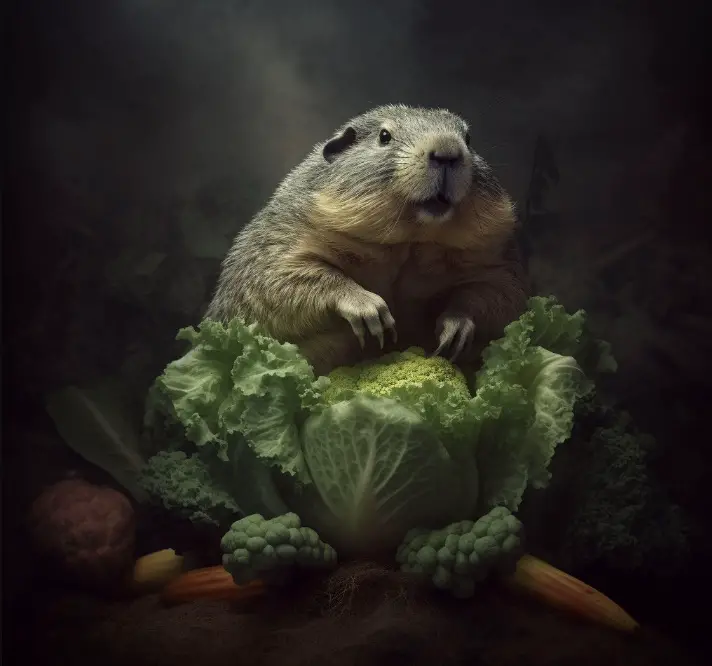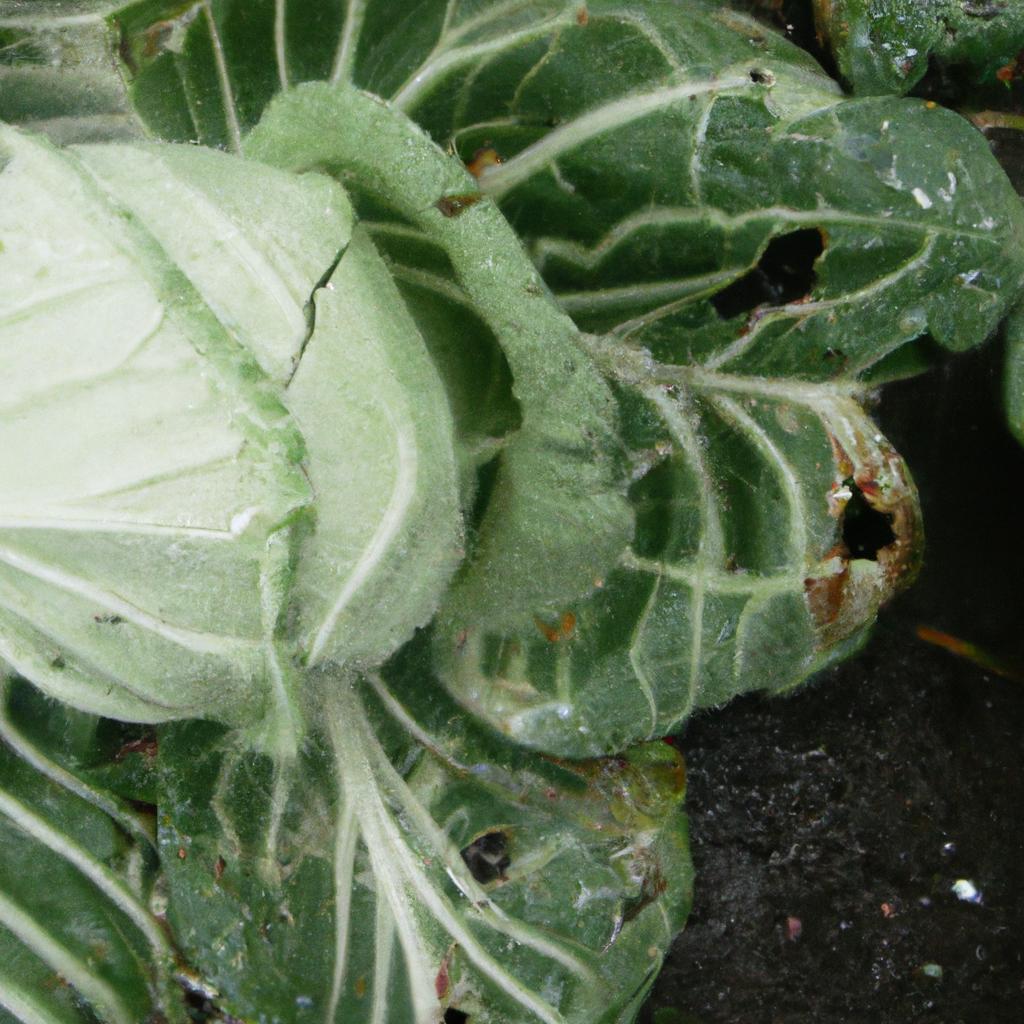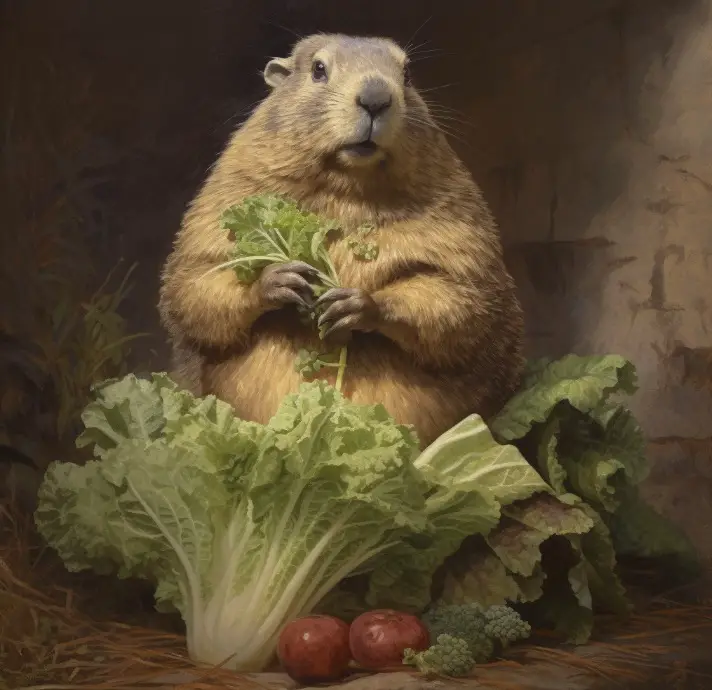Growing my own produce has always been a passion of mine.
There’s something so satisfying about planting seeds, nurturing them, and watching them grow into beautiful, leafy vegetables.
But every gardener has faced the frustration of animals eating their hard work.
Over the years, I’ve dealt with various critters, and one animal that’s been a common visitor to my garden is the groundhog.
So, it got me thinking: do groundhogs eat cabbage?
The short answer is yes, groundhogs do eat cabbage. But there are ways to avoid it!
Now, let’s dive a bit deeper into the topic, discussing when, how, and how often these animals feast on our leafy greens, and what implications this may have for backyard owners like us.
Contents
Groundhogs: A Brief Overview
Before we dive into their eating habits, let’s get to know a bit more about groundhogs.
Groundhogs, also known as woodchucks or whistle-pigs, are large rodents belonging to the marmot family.

They are native to North America and are usually found in lowland areas, meadows, and grasslands.
Groundhogs are well-known for their burrowing abilities, and they dig complex burrow systems underground to live and hibernate in.
When Do Groundhogs Eat Cabbage?
Groundhogs are diurnal animals, which means they are most active during the day. They usually come out of their burrows in the early morning and late afternoon to forage for food.
This is when they are most likely to eat your precious cabbage.
How Do Groundhogs Eat Cabbage?
Groundhogs have strong teeth that allow them to efficiently chew through the leaves and stems of cabbage. They can eat quite a lot in one sitting, often consuming large portions of a cabbage head or multiple leaves, leaving the plant ravaged.

How Often Do Groundhogs Eat Cabbage?
Groundhogs are primarily herbivores, which means that their diet consists mainly of plants.
They eat a variety of vegetation, including grasses, weeds, and garden crops.
While they don’t exclusively eat cabbage, it is a popular food choice for them due to its tender leaves and easy accessibility in gardens.
During the spring and summer months, when groundhogs are most active, they will eat more frequently.
They need to build up their fat reserves for the winter hibernation, so they might visit your garden several times a week, or even daily, to snack on your cabbage and other vegetables.
Why Do Groundhogs Eat Cabbage?
Cabbage is a nutritious food source for groundhogs, providing them with essential vitamins and minerals. It is also a relatively easy source of food for them to access, as cabbage plants grow low to the ground and are not as challenging to reach as some other crops.
Here are a few reasons why groundhogs might eat your cabbage:
- Availability: Cabbage is a commonly cultivated vegetable in many regions, and groundhogs often encounter it in gardens and agricultural areas. If cabbage is easily accessible to them, groundhogs may take advantage of the food source.
- Nutritional content: Cabbage is relatively high in nutrients and contains essential vitamins and minerals. It provides a good source of dietary fiber, vitamin C, vitamin K, and folate. Groundhogs, like other herbivores, instinctively seek out food that meets their nutritional needs, and cabbage can contribute to their overall diet.
- Palatability: Groundhogs may find cabbage appealing due to its taste and texture. While taste preferences can vary among individuals, cabbage leaves have a crisp and slightly sweet flavor that may be attractive to groundhogs.
- Seasonal factors: Groundhogs are known for their burrowing habits and hibernation during the winter. When they emerge from hibernation in the spring, they may encounter fresh cabbage leaves as part of the early-season vegetation. The availability of young cabbage plants during this time could make them an easy and appetizing food source.
- Opportunistic feeding: Groundhogs are opportunistic eaters and will consume a wide range of plant material. If they come across cabbage while foraging, they may sample it out of curiosity or as an alternative food source if their preferred options are scarce.
It’s important to note that groundhogs can be pests to gardeners and farmers because they can cause damage to crops.
If you’re experiencing problems with groundhogs eating your cabbage or other plants, it may be necessary to implement measures to deter them from your garden or protect your crops.
Implications for Backyard Owners
As a backyard owner, the fact that groundhogs eat cabbage can be quite frustrating. These animals can cause significant damage to your cabbage crop, potentially ruining your entire harvest.

In addition to the loss of produce, groundhog burrows can also cause structural damage to your garden, as their tunnels can weaken the ground and cause it to collapse.
Other Animals That Eat Cabbage
Unfortunately, groundhogs aren’t the only animals that enjoy munching on cabbage. Other animals that might eat your cabbage plants include:
1. Rabbits
2. Deer
3. Slugs and snails
4. Cabbage loopers (caterpillars)
5. Cabbage worms
How To Keep Groundhogs Out Of Your Yard!
There are several things that can be done to prevent groundhogs from digging and eating stuff in your backyard. I will list some of the strategies below.
Also, see my recent post if you want a full list of my favorite methods to keep groundhogs and gophers away!
1. Using ultrasonic sound
Groundhogs, like other bigger mammals that may invade your garden, tend to have very good hearing. This means that loud or consistent noises will scare them away or at least shorten their visits.
Check out my full buying guide for these ingenious ultrasonic repeller devices here!
One of my favorite technologies to keep pests away from my backyard is these cool solar-powered ultrasonic sound emitters that you can buy right from Amazon! In my experience, they really work, and the solar panels on top save you the time and money of changing batteries all the time.
They will also work against other rodents like gophers, mice, and rats!
2. Sprinkling natural repellents
Groundhogs may be scared off by using natural scents such as coyote urine or predator scents.
They may also cause them to leave if there is a combination of sounds being played from a radio. The sounds include the sound of barking dogs and coyotes.
You can sprinkle dog hair, cayenne pepper or strong enteric oils and other natural repellents around the garden to keep the groundhogs away.
See my complete list of humane ways to keep groundhogs away from your yard for more tips and tricks!
3. Fencing around the garden
You can also fence around your garden to keep groundhogs from entering the garden. It should be at least 3 feet deep and have a double row of fencing.
Groundhogs are good diggers so it has to go underground or they may find a way into the garden even with the fences in place!
4. Using live traps
You can use a live trap to capture groundhogs and move them to another area. Live trapping is currently the most humane way of groundhog control. Once you have removed all groundhogs from an area, it is important to ensure that they do not come back by using fencing or other barriers to block access.
You can also just buy a live trap, as the sturdy metal ones shown here:
To lure the groundhogs in, you can use one of the numerous favorite foods of groundhogs or an optimized extra attractive formula like this one to make the catch even quicker!
5. Using natural pesticides
There are pesticides or rodent toxins that can be used to kill groundhogs on your property. These may also affect other animals in the area so it is important to ensure that they are only sprayed on the targeted plants.
I do not recommend these, as I prefer more humane ways as described here. Also, anything that kills an animal will also harm humans to some degree, so go for a repellant rather than a toxin if you go the chemical route!
6. Using Scarecrows
You can use a scarecrow in your garden to keep groundhogs away. Groundhogs are afraid of novelty so time-sensitive or motion-activated scarecrows may also be effective in keeping them out of the garden.
7. Using Lights
Groundhogs are not strictly nocturnal animals but they are most active at low light so they do avoid areas with bright lights.
Motion-activated lights, sounds, and sprinklers may help prevent groundhogs from entering your yard.
Any blinking light will confuse and scare away groundhogs from your yard, especially if they are motion activated and sudden!
8. Motion-activated sprinklers
Like most animals, groundhogs hate surprises, and they will run away if suddenly sprayed with water. I like this solution because it is humane, simple, effective, and does not require much time to set up.
The Havahart 5277 is a motion-activated sprinkler that is activated by the movement of animals up to 25 feet away and sprays them with a harmless water jet, frightening them off and keeping them at bay.
The included metal stake makes it easy to install in your garden, and the sprinkler can be rotated 180 degrees for maximum coverage.
## Conclusion
Groundhogs do eat cabbage, and they can cause significant damage to your garden in the process.
As backyard owners, it’s essential to be aware of the animals that might be feasting on our hard work and take appropriate measures to protect our plants.
While it can be frustrating to deal with these critters, understanding their habits and needs can help us coexist with the wildlife in our backyards.
Happy gardening!















